AMD's 65nm Brisbane Core Previewed: The most energy efficient AMD CPU to date
by Anand Lal Shimpi on December 14, 2006 6:08 PM EST- Posted in
- CPUs
3D Rendering Performance & Power Usage
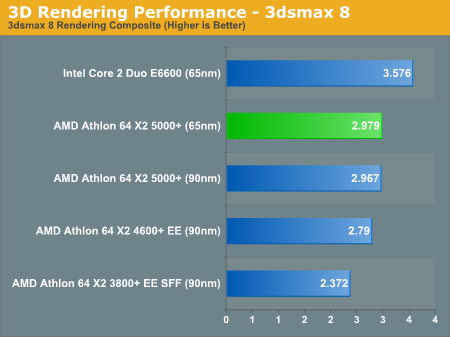
Looking at 3D rendering performance, Intel's Core 2 Duo still comes out on top in performance, but once again our focus this time around is on power consumption, so let's have a look at that.

There's a noticeable reduction in total system power consumption with the move to 65nm, but AMD's EE/EE SFF and Intel's Core 2 processors all draw less power than the new 5000+.
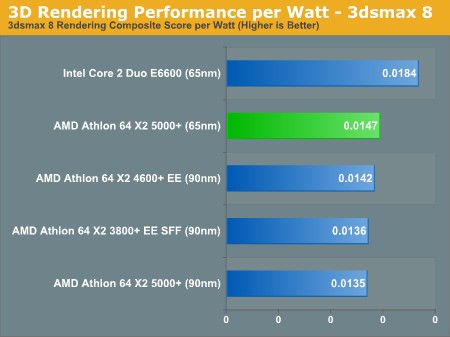
Looking at efficiency however, Brisbane is the best AMD has got to offer. It is still no where near the performance per watt you can get with Intel these days, but it's a step in the right direction. If AMD's updated micro-architecture can narrow the performance gap next year, we may see some competition in the performance and performance per watt space once again.
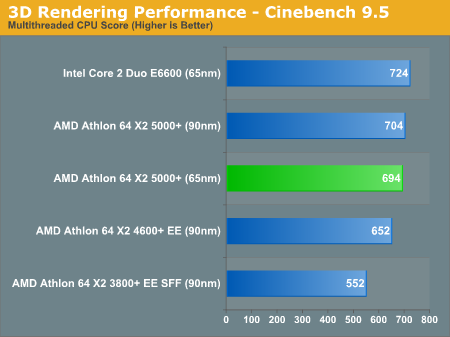
The performance under Cinebench is far closer between the E6600 and the X2 5000+, with the slight nod going to the Core 2 CPU.
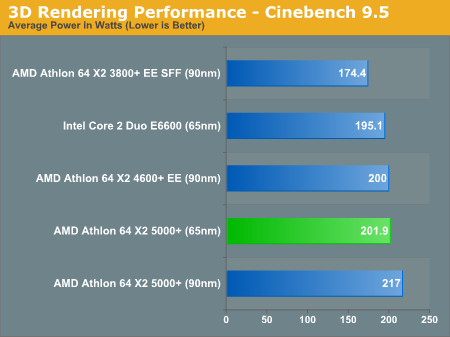
Power consumption is also relatively close between the two CPUs, with Intel once again coming in a bit lower at 195.1W. The move from 90nm to 65nm shaves off about 15W of total system power consumption, which isn't bad given that there's no change in processor pricing.
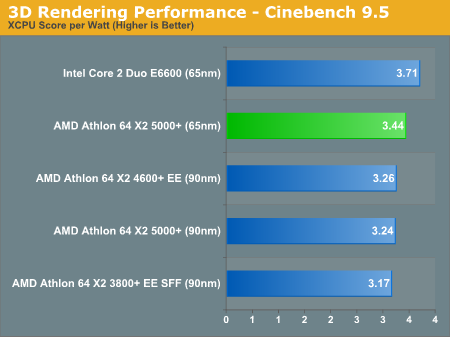
Performance per watt is close between Intel and AMD, closer than in any of our other tests, but Intel ends up with the overall win. Looking just at AMD CPUs, the Brisbane core continues to offer better performance per watt than even the most efficient 90nm X2s AMD had previously offered.










63 Comments
View All Comments
Anand Lal Shimpi - Friday, December 15, 2006 - link
Part 2 is coming Monday with Brisbane 4800+ results :)Take care,
Anand
Anand Lal Shimpi - Monday, December 18, 2006 - link
Just an update guys - Part 2 is ready to go, just waiting for a few clarifications from AMD on performance, memory dividers and die size of Brisbane.Take care,
Anand
OcHungry - Friday, December 15, 2006 - link
Mr. Anand, is it possible that you use Asus's Crosshair motherboard if attempting for the max overclocking of these 65nm's? It's only fair when you use top Intel board but leave out top AM2 board. I have an understanding that Asus's Crosshair board is ~ 15%-17% better performer than other boards. Also I've heard that the DFI board is a great Overclocker and you have used it on the s939 reviews. I would appreciate it if you use either board, but preferably the Asus Crosshair.Thanks.clairvoyant129 - Sunday, December 17, 2006 - link
A different motherboard won't save this sorry ass piece of junk.Anand Lal Shimpi - Friday, December 15, 2006 - link
Unfortunately I don't have either of those boards here for testing, but I'm sure I can persuade either Gary or Wes to do a follow-up with a more serious look at 65nm overclocking once I'm done with the power analysis on these chips. :)Take care,
Anand
xenon74 - Friday, December 15, 2006 - link
Jarred, why is then HT Link @ 1125Mhz on Anand's "unfortunate" OC attempt?ADDAvenger - Friday, December 15, 2006 - link
Anyone else wondering what this means for the new generation of Turion X2s?I know Santa Rosa is coming out either Q1 or Q2 this year; it's supposed to support an 800 or 400mhz FSB, depending on system load, which should drop power consumption a bit. But, as I understand it, the real battery suckers are CPU, display, and HDD. (Yeah throw in GPU too if you have discrete graphics.) But where does that leave the chipset, will Santa Rosa really do much for battery life?
If not, AMD could make serious inroads into the laptop segment. 65W is hot for a laptop, but if they can drop their desktop TDPs by about a 1/3 or 1/4, why can't they do the same for their laptop chips?
mino - Friday, December 15, 2006 - link
They can. And they will...FYI even 90nm Turions consume LESS power than Merom. (Merom is more power hungry than Yonah).
Also RS690M is about to rule the integrated market (along with RS700M for C2D). In other word AMD is gonna rule the chipset market for both platforms while beeing pretty competitive in CPU's, especially for bussiness use.
(for bussiness the features and battery life is what counts, not the absolute performance)
Johnmcl7 - Friday, December 15, 2006 - link
Not according to Anandtech:http://www.anandtech.com/cpuchipsets/showdoc.aspx?...">http://www.anandtech.com/cpuchipsets/showdoc.aspx?...
Shows power consumption to be as near as identical between the two processors.
Not sure if you are comparing Turion or Turion X2 to Merome but aside from mismatched comparisons (such as comparing the power consumption of a Turion system with onboard graphics and Merom with dedicated graphics) I've not seen like for like tests showing Turions to be more power efficient:
"Does that make the Core 2 Duo worse at power saving than Turion X2? Without equivalent setups (i.e. both using IGP or both using discrete GPUs), we can't say for certain. We can say that an ASUS W5F with a T2300 chip (1.67GHz 2MB cache) that we had at one point bottomed out at 19W in idle mode, so Core Duo and Turion X2 appear close in low power states, with Turion X2 perhaps holding a slight 1-2W advantage. Our testing of Core Duo vs. Core 2 Duo showed the CPUs to be nearly equal in power draw, so it appears AMD is equal or slightly better than Intel at minimum power draw. At maximum power draw by the CPU, Turion X2 is definitely using more power than Core 2 Duo, as even with higher performance/power components the ASUS A8JS still uses less power than the MSI TL-60 at 100% CPU load."
http://www.anandtech.com/showdoc.aspx?i=2856&p...">http://www.anandtech.com/showdoc.aspx?i=2856&p...
John
rqle - Friday, December 15, 2006 - link
Darn, was so hoping AMD 65nm would give an easy 3.3ghz+ like the intel chips =(. This chip may not reflect overall OC, but it damn hovering around my AMD range of 2.6-2.8 again. A 2.66-2.7 OC intel is > then 2.9ghz AMD. Ill just waited again.